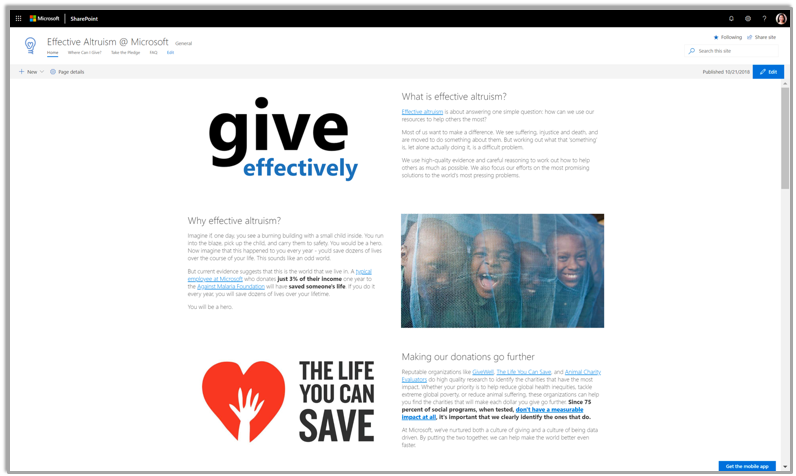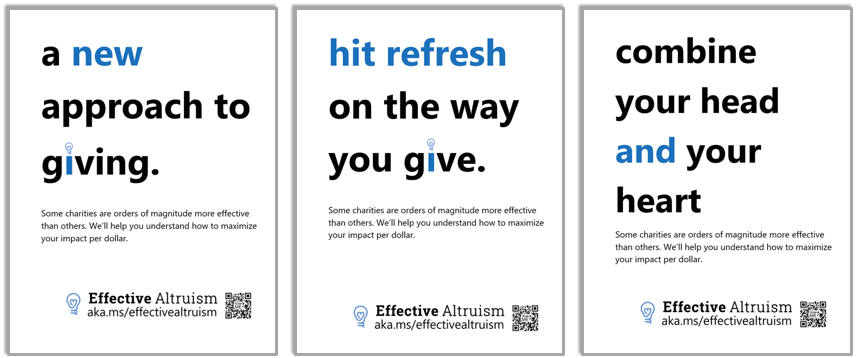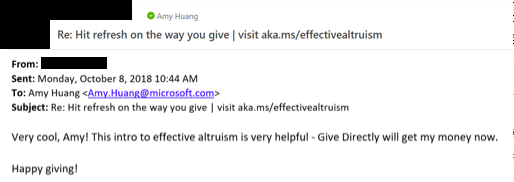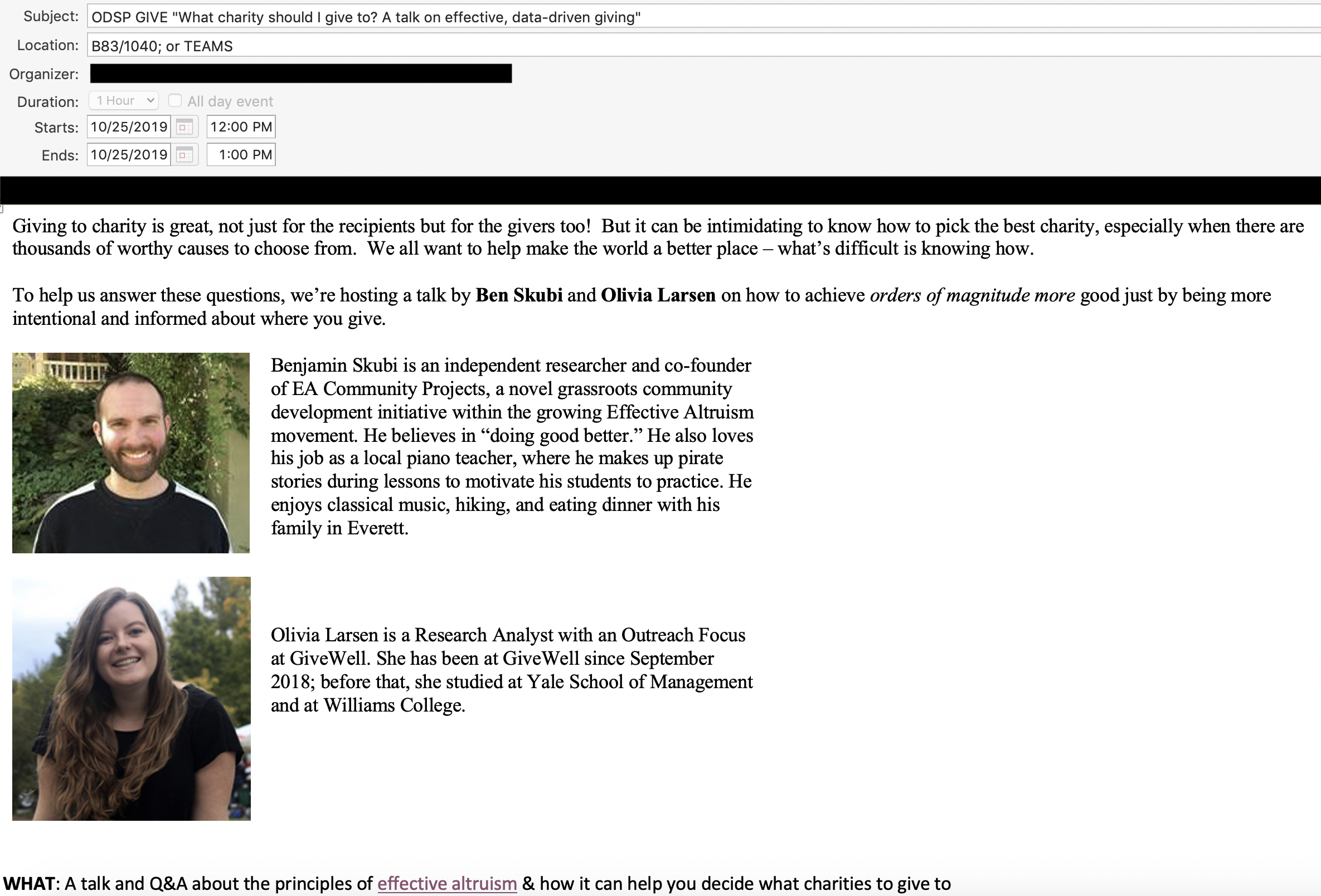tl;dr
Large tech companies employ hundreds of thousands of people, many of whom are financially well-off and want to help the world, but who are not aware of the effective altruism movement. Because there are already many EA folks working at these companies, and because many of these companies already have the culture and infrastructure to encourage/promote giving (ex. events, donation matching), this presents a huge opportunity to promote and build an EA mindset at these companies.
Introduction
GiveWell believes their best approach to finding more donors is to reach more people who are demographically similar to their current donors, but have not yet heard of them or effective altruism, namely young professionals in the tech or finance professions — people “with a quantitative mindset.”
I work at Microsoft, a company where employees donate over $150 million dollars a year to support nonprofits and schools. Microsoft provides 100% donation and volunteer time matching up to $15k per employee in the US, effectively doubling every donation’s impact.
The company also has the entire month of October officially dedicated to charitable giving, called the Give Campaign. During the Give Campaign, teams host lots of fun and interesting events (Poker tournaments, 5ks, cat calendars, etc). Employees are highly encouraged to attend these events, with execs chiming in and mails sent out on participation rates. A few employees are even given a 6-month break from their regular tasks to focus almost exclusively on organizing events for their team.
But while the company proudly declares itself to be data driven (and it is in many ways), this has not translated to its giving program. Employees are highly encouraged to give, but are not encouraged to give effectively. Most employees attend events based on interest in the activity, and are often unaware of what cause the event even benefits.
This seemed to present an opportunity.
How we came together
Evan Sandhoefner started a Microsoft Effective Altruism Facebook group and added random Microsoft employees to it. Though the group was minimally active, it was enough for a few EAs to find each other. A couple weeks before the 2018 Give Campaign officially started, I made a post asking what we could do to encourage effective giving at the company. Amy Huang reached out to me and we started bouncing around ideas.
Over time, we met others who expressed enthusiasm and interest in what we were trying to do, and joined our team: Alex Bitiukov, Ayo Olubeko, Jessica Yang, and Sonia Jaffe.
What we did
Year 1: 2018
The first year, we launched an internal campaign during the main Give Campaign to raise awareness of the ideas of effective altruism within the company. We started off by creating an internal site that talked about effective altruism and made the case for why it was important. The site took a lot of text from the main https://www.effectivealtruism.org/ website, but looked to appeal specifically to Microsoft employees.


We also had links to take site visitors to the company’s internal donations page for various EA-recommended top charities.
The next thing we did was put up posters for EA all around campus. This was not trivial for a two-person team, as the Microsoft main campus alone has over 100 buildings, and a typical building had 4–5 floors. On each floor, we put our posters on any available poster-boards we saw, but also by elevators and by bathroom doors (basically, anywhere there was a precedent for putting up posters). We got to postering up ~20 buildings.

We also sent out promotional emails to various internal mailing lists (Hack for Good, Vegans at Microsoft, Indians at Microsoft, etc) and even some teams. In each of these, we tried to explain why EA or EA principles would be interesting or relevant to the group, and linked them to our website to learn more. We also created an internal EA mailing list for any interested employees to join.

We received very positive responses to these mails. People thanked us for introducing the concept to them, people told us they would now change their giving decisions, and it helped us connect with other EAs at Microsoft.



Additionally, in Boston, which is a much smaller office than the main campus, our remote team member was able to convince a few event organizers to switch their sponsored causes from randomly-chosen ones to more effective charities. They also got one large team to link to our internal EA site to their team-wide Give Campaign site. However, both these attempts worked best where there was a personal relationship with the organizers. Where the relationship wasn’t present, our team member was met with some hostility.
Finally, some of us added an email signature to our everyday mails. Mine looked like this:

Another colleague’s signature looked like this:

One big win was that ~350 unique users had visited our website and had now heard about EA. We didn’t know how often that would translate to donations or mindset changes, but between that and all our other efforts, we knew we had helped plant some seeds.
Year 2: 2019
The second year, we again leveraged the timing of the official Give Campaign, but decided to do things differently: we decided to host a talk. Various charities were already booking events at the company and putting invites on thousands of employees’ calendars for their cause areas, and we realized we could do the same. We didn’t know much about booking/organizing an event, but we gave it a shot anyway.
I’d previously attended a Seattle EA meetup, so I reached out to its organizer to find out if she knew anyone who’d be a good speaker. She recommended me Benjamin Skubi, co-founder of EA Community Projects, as someone who was passionate and would be interested, and put me in touch with him. Meanwhile, my partner in organizing, Alex Bitiukov, reached out to GiveWell, and research analyst Olivia Larsen said she’d be happy to make a trip up. We decided they could be both be speakers: Benjamin would talk about EA and what it was, Olivia could talk about what GiveWell was and did, and then they could both take questions.
We got a room booked, got a date set, and worked on getting invites out. Apart from sending invites out to the internal mailing lists mentioned above, we also reached out to various teams’ Give Campaign leads about making this an official event for their team. These team leads were generally delighted by our efforts, and were quick to agree. Unlike the previous year, where the Microsoft Philanthropies’ employee engagement department felt we weren’t helping the “Give to the causes you care about and be happy and have fun!” mentality they were trying to foster, these leads were delighted to have more events to invite their team to.
This was the invite we sent out:

We presented the talk as a potential answer to a problem we suspected a lot of employees have, something like “I am well off and I want to give to charity but there are so many and I don’t know where to give”. My primary inspiration was something I heard Kelsey Piper (TheUnitOfCaring) say on the 80,000 Hours podcast:
I think people find effective altruism most compelling when it is answering a question that they have an answer to, and that’s something we sometimes fail at as a community, because for example, I think most effective altruists about like education in the US are kind of like “The answer to education in the US is that it’s not a good place to spend money on at this time.” But I think when you can, demonstrating how the effective altruist approach gives useful answers on a question that people already care about is a good way to make them care about it as an approach, and therefore care about the answers it gives to other questions.
We got the invite out to some thousands of people, and we had ~80 people tune in for the talk. People seemed engaged, asked questions, and multiple people thanked us for the talk.
What we learned
- Many, probably even most, people in tech companies have never heard about EA, and many (though not all) do see at least some value in it.
- It only takes one. The difference between having zero and one other person to help you organize is everything.
- Presenting EA as an answer to a question people already have seems to get a lot of people interested.
- Most people still give with their heart. It’s valuable to tell an emotional case for EA that elicits the warm fuzzies, even if the methodology does not.
- When organizing a company-wide talk/event, giving people a way to tune in virtually is vital. Only two people showed up in person for our talk, while the rest joined over conference call or watched a recording of our talk.
- People seemed more amicable/receptive to EA when it wasn’t presented as an all-or-nothing approach (i.e. calling out their donations don’t have to be 100% to EA-recommended charities).
- Putting up posters across our large campus and dozens of building was both a lot of work and didn’t seem to get people to look into EA more. But sending mails/invites got us good traction.
- If you’re looking to promote EA at a company, avoid fighting uphill battles as much as possible. Many people are wired to be averse to EA style thinking, and many have personal and/or professional priorities that go counter to EA advocacy. But whenever you can present your EA advocacy goals as aligned with theirs, people will be very willing to work with you.
- Similarly, look for allies and potential advocates in more places. By including people from other offices, teams and cross-promoting EA with other groups that might be interested (ex. veg*ns, social justice groups, etc), we were able to extend the reach of our messaging.
- Advocating for EA is fun! I met some great people doing this that I otherwise would not have, and I got to spend my time working on something I really cared about, and thought mattered.
What you can do
I encourage everyone who works at a large and/or tech company, especially ones that already have a charitable culture and infrastructure, to look into promoting EA. Microsoft is just one company — if something like this gets done at every such company, we can drive towards some real change. It only takes a couple people at each place to drive something like this forward, and there is some real low hanging fruit.
If you work at Microsoft and want to help out next year, you can contact us at effectivealtruism@microsoft.com. While we’re happy with our efforts and results in the past couple years, we expect that with our learnings we will make an even bigger splash next year. Even if all you’d want to do is write an email to your team’s Give Campaign lead, that 10 minutes of your time can translate to another 1000+ people hearing about EA.
If you work at another company, are interested, and want to find others who are interested, you can leave your email here (or connect up with someone who already has). Check out this folder of key resources we compiled and feel free to use anything you find useful. You can also reach out to me at pathayan@microsoft.com, or my co-founder Amy Huang at amyh@gfi.org, if you’d like to ask us anything. We’re happy to answer any questions and provide any guidance you might want or need.

Thanks so much for posting about your experience, I anticipate your tips will help me improve my strategy for incorporating EA concepts at the large corporation I work in. I'll chime in with my own experiences in case they are also helpful to others.
I work in a Canadian company with 50k employees. In early 2019, I reached out to our company's charitable giving team, expressing an interest in helping run events to increase charitable giving engagement within my part of the business. This invitation was met with enthusiasm and support, over 2 conference calls and several emails. I didn't explicitly mention EA, just that I was well connected and had a fun systematic way for looking at charitable giving.
As we approached the giving campaign period in the fall, I reached out again with an exciting proposal to run a Giving Game, and asked if it could be included as an official charitable giving campaign event. This didn't end up working out (reasons are opaque to me, a few emails went by without response), but I'm hopeful for 2020. Instead, I invited folks from my network to attend, and we had a really good 10 person Giving Game.
This was the first one that I've run, and it seemed to land really well with the attendees. One key aspect was to show employees how they could donate to effective charities through RC Forward, directly from their paycheck. I hope to leverage their testimonials to support whatever proposal I come up with this year.
I think there is a lot of potential to incorporate EA concepts into a greater conversation at my company, and see two paths forward:
1. Grow a grass-roots conversation by finding people who are enthusiastic enough about EA to actually form a core team. Currently it's just me by myself, and this seems like a work-intensive long-term goal.
2. Shortcut the process by building a stronger relationship with our charitable giving team. Changes made by this team could be very high leverage - anything from changing the company matching program to include high impact charities (we don't), to tweaking default donation options and search functionality, to a paradigm shift in how folks view doing good.
I'm also playing with system-wide influence through a new role that I've taken on, which could transform the company culture. It's still early days, but I'm making meta-moves to create a community that increases empathy, connection, and systematic (rational) thinking.
Hoping my story is helpful for folks here. I'm interested in hearing more anecdotes from anyone else who's looking at EA from the context of a corporation.
Hi Naryan - this sounds like great work, well done. One for the World may be able to help you with your 2020 plans (www.1fortheworld.org). We're a network of people giving 1% of their income to the GiveWell charities and have a couple of chapters in Canada. My email is jack [at] 1fortheworld [dot] org - please do get in touch!
This is awesome - thanks for writing up!
For people working in the UK and keen to do something like this, I'd love to chat: ben@tyve.org
We launched an employee giving tool (Tyve.org) which promotes recommended charities from GiveWell and Founders Pledge's research.
This is really cool! Thank you for doing this!
Also, I'm curious - to what extent is AI safety is discussed in your group?
I noticed the cover of Superintelligence has a quote of Bill Gates saying "I highly recommend this book" and I'm curious if AI safety is something Microsoft employees discuss often.
Hi Parth, thank you so much for this post, and for the great work you and your fellow EA organizers are doing at Microsoft!
I live in SF, and have been brainstorming with a few EAs re mobilizing EAs in tech companies (in addition to general EA movement building in the city). Will definitely try to learn from your experience and reach out for more questions if that's ok.
I also wonder if you guys have a broader strategy for EA community building at Microsoft, and/or other EA meetups there (or directing people to EA Seattle)? Also, do you have a way to track your (estimated) impact?
(Also, this is Microsoft specific, but does Bill Gates do any speaking events on global health or effective giving there? Perhaps he stays away to avoid being seen as meddling in the company... If he's willing to do it I can see it attracting a huge crowd.)
Hi Sindy, thanks for the kind words! Really cool to hear you’ve been looking into doing that, and I’d be interested in hearing more. And of course you’re more than welcome to reach out if you have any questions.
I can’t speak for everyone involved, but off the top of my head, my rough strategy is something like:
Our main metrics today are simply site visits, people tuning into our talks, and feedback we receive. Donations to/through GiveWell from Microsoft is something we could maybe track if they are willing to share that information, but that’s not a conversation we’ve had yet.
Bill Gates has stayed away from mixing his Foundation work with Microsoft, as far as I can tell. Our team’s never talked about reaching out to him for support, but maybe we should ...
This is fantastic - great to see someone do this, and the branding you came up with is super nice (especially around "do orders of magnitude more good"). In my experience people tend to keep quiet about EA while at work; good to see that trend being bucked as this seems like an obviously underutilised way to get folks interested the movement.
This work sounds great! Thanks for writing it up in such a clear way for others to learn from.
I have a friend who works at Apple. He is somewhat familiar with effective altruism (I've mentioned it to him before) but doesn't seem too charity-driven. What ways would you recommend approaching him with this issue? Perhaps he could spread the word there.
Thanks for sharing. I just started at Microsoft and will be reaching out to the mailing list to see how I can get involved.
One question / note:
Did you actually measure how many people took some action based on the posters?
For example, by putting a URL that went to a web page with analytics?
If not, you might try that.
Sometimes it's a bit counter-intuitive what things work. For example, from Rationally Speaking, I learned
Prior to hearing that I'd assumed they were a big waste of money. So the same might be true of posters in Microsoft buildings.